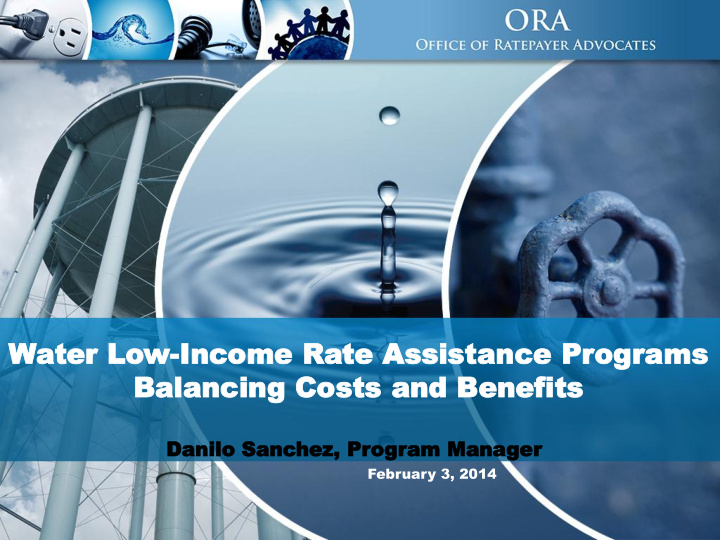



Wate ter r Lo Low-Inco Income me Ra Rate te Ass Assista istanc nce e Pr Prog ograms ams Balancing Balan cing Cos Costs ts an and d Ben Benefits efits Da Danil ilo San Sanchez, z, Pr Program m Man Manager February 3, 2014
Who W ho We A e Are ORA – the Office of Ratepayer Advocates - is an independent consumer advocacy office within the California Public Utilities Commission (CPUC). ORA’s statutory directive is to represent and advocate on behalf of all residential and small business utility customers to obtain the lowest possible rate for service consistent with reliable and safe service levels (Public Utilities Code Section § 309.5). The Voice of Consumers, Making a Difference! 2
How ORA Ho w ORA Adv Advoca ocates f tes for or Affor Af orda dable ble Water ter Ra Rates tes ORA scrutinizes water utility operations, infrastructure, and rate requests to ensure service is provided at the lowest rate while remaining safe and reliable. ORA advocates for strong low-income water programs to ensure those most in need have access to a monthly subsidy to reduce their water bills. ORA also evaluates the impact on the remaining customers who pay to fund low-income and other programs. To achieve mandated conservation goals ORA promotes cost-effective conservation programs that also reduce energy demand in the pumping, treatment, and delivery of water. ORA actively engages with customers by participating in community meetings, public participation hearings, and other venues. ORA provides a voice for utility customers in formal proceedings at the CPUC and negotiates settlements when they benefit customers. The Voice of Consumers, Making a Difference! 3
In Investor estor-Owned Owned Water ter Util Utility ity Lo Low-Incom Income e Ra Rate Assi te Assista stance nce Public Utilities Code Section § 739.8 allows the CPUC to implement low-income rate assistance programs. Each water utility with greater than 10,000 customers has a low-income rate assistance program. Customer eligibility is based on income. For example, for a family of four, incomes from $37,800 to $43,200 qualify. 1 Discounts are between $4 - $23 per month, depending on average bills. Programs are evaluated every three years in the general rate case. Funded by remaining customers at a cost of $0.93 to $7.06 per month. 2 1. http://www.cpuc.ca.gov/PUC/Water/wateralternativerates.htm (accessed 1/24/14). 2. www.cpuc.ca.gov/.../PPD WaterLowIncomeRates Final20130826.pdf, Low-Income Rates for Water Utility Customers, Policy and Planning Division, August, 26, 2013, page 10. The Voice of Consumers, Making a Difference! 4
Lo Low-Income Pr Income Prog ogram am Enr Enrollment ollment at t Highest Highest Le Levels els Enrollment in Water Low-Income Rate Assistance Programs increased 115% among the largest investor- owned water utilities with the CPUC’s adoption of data sharing with energy investor-owned utilities (Rulemaking 09-12-017, Decision 11-05-020). 1 2012 average single-family residential customer enrollment levels for Low-Income Rate Assistance among the large investor-owned water utilities is approximately 21%. 2 This compares favorably to the CPUC’s estimated average eligible percent of households of 26%. 3 1. Calculated by ORA using enrollment data prior to and after data sharing, presented by the CPUC’s Division of Water and Audits to the Low-Income Oversight Board, August 21, 2013. 2. Calculated by ORA using enrollment levels reported to the Low-Income Oversight Board by the CPUC’s Division of Water and Audits, August 21, 2013. 3. Low-Income Rates for Water Utility Customers, Policy and Planning Division, August, 26, 2013, page 10, based on census data. The Voice of Consumers, Making a Difference! 5
Key ey Facts tha acts that I t Impact Lo mpact Low-Income Income Ra Rate Assi te Assista stance nce Pr Prog ogram Design am Design California investor-owned water utilities only represent 4% of total urban water use. The remaining 96% of water is provided by non-PUC regulated water districts, agencies, and municipalities. Large water utilities combined have a total of approximately 1.3 million service connections; of those, approximately 1.17 million or 89% are residential customers. Smaller water utilities do not have the economies of scale to support higher subsidies for low-income rate assistance programs. Increasing subsidies for low-income customers puts a higher cost burden on remaining non-qualifying residential customers. Consideration must be given to affordability of all customers including rates for remaining residential customers. In some cases, customers funding the program are close to qualifying for the program themselves. The Voice of Consumers, Making a Difference! 6
Various arious Mec Mechanisms A hanisms Availa vailable to Help ble to Help Maintain aintain Water Af ter Affor orda dability bility in C in Calif alifor ornia nia Level payment plans for residential customers. Offering payment arrangements. Water conservation programs. Rate Support Fund. The Voice of Consumers, Making a Difference! 7
Contact Contact Danilo Sanchez Program Manager, Water des@cpuc.ca.gov (415) 703-2771 The Voice of Consumers, Making a Difference! 8
Recommend
More recommend